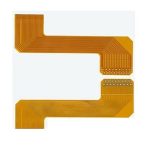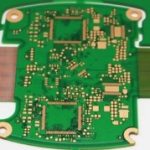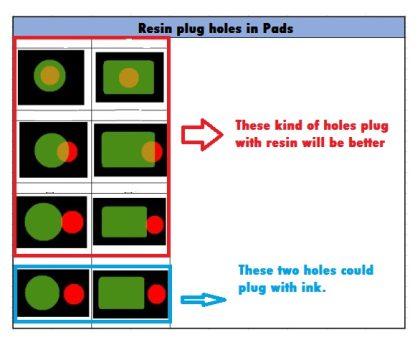Through-hole lines with each other to connect the role of conduction, the development of the electronics industry, and also to promote the development of PCB, but also the production process of printed circuit boards and surface mounting technology put forward higher requirements. Surface mounting technology to put forward higher requirements. With the development of electronic products to “light, thin, short, small” direction, PCB also to high-density, high-difficulty development, so there are a large number of SMT, BMT, BGA, BGA, BGA, BGA, BGA, BGA, and so on. Therefore, a large number of SMT, BGA PCB, and customers in the mounting of components required to plug holes, there are five main roles:
(1) to prevent the PCB over wave soldering tin from the lead hole through the component surface resulting in a short circuit; in particular, we put the over-hole in the BGA pads, it is necessary to First plug holes, and then gold-plated processing, to facilitate the welding of BGA.
(2) Avoid flux residue in the via hole;
(3) Electronic factory surface mounting and component assembly is completed after the completion of the PCB in the test machine to suck the vacuum to form a negative pressure before completion:
(4) To prevent the surface solder paste into the hole caused by false soldering, affecting the placement;
(5) Prevent the wave soldering of tin beads popping out, resulting in a short circuit. comfortstar circuit board
Plug hole type
(1) resin plug holes: the use of the solvent-free (Solvent) nature of the ink plug holes, in addition to complementing the general ink makes not easy to fill the problem, but also reduces the ink by heat and produces “the”. Ink heat and produce “cracks”. Generally for the vertical and horizontal comparison of the aperture when used.
Benefits of Resin Plugging
– The use of resin to plug holes in BGA can reduce the distance between holes and solve the problem of wires and wiring;
– Buried holes in the inner HDI can balance the press-fit dielectric layer thickness control and the inner HDI buried holes to fill the contradiction between the design;
– Board thickness of the larger through-hole, can improve product reliability;
– PCB using resin plug holes this process is often because of BGA parts, because the traditional BGA may be done between the PAD and PAD VIA to the back to go to the line, but If the BGA is too dense, resulting in VIA can not go out, you can directly drill holes from the PAD to do via to other layers to go to the line, and then fill the holes with resin copper-plated into the PAD, which is commonly known as the PAD, which is also known as the copper plating. PAD, which is commonly known as the VIP process (via in pad), if only the PAD via without resin plug holes, it is easy to cause tin leakage leading to short circuits on the back and empty front. If the via-in pad is not plugged with resin, it will easily lead to tin leakage and short circuit on the back side as well as empty solder on the front side.
PCB resin hole plugging process includes drilling, plating, hole plugging, baking, grinding, drilling the hole plating through, then plugging the resin baking, and finally grinding to smooth, grinding, grinding, and so on. Finally, it is grinding to smooth out the resin after grinding because it does not contain copper, so it is also necessary to plating a layer of copper to turn it into PAD, these processes are in the original PCB drilling process. These processes are done before the original PCB drilling process, that is, the first to plug the hole to deal with the hole, and then drill other holes, according to the original normal process to go. Plug holes if not plugged well, there are air bubbles in the hole because the bubbles are prone to moisture absorption, the board and then over the tin oven may burst the board, but plug holes in the process of If there are bubbles in the holes, the bubbles will extrude the resin when baking, resulting in the case of one side of the depression and the other side of the protrusion, at this time you can check out the defective products, and the board with air bubbles do not necessarily have to go. There are bubbles in the board do not necessarily burst the board, because the main cause of the burst board is moisture, so if the board just out of the factory or the board in the upper part of the board after baking baking, generally speaking, will not cause the burst board.
(2) electroplating filler
Currently is to use the characteristics of the additives to control the growth rate of each part of the copper to fill the hole action. Mainly used in continuous multi-layer stacked hole production (blind hole process) or high current design.
Advantages of plating hole filling
– Facilitates the design of stacked and on-disk holes;
– Improved electrical performance for high-frequency designs;
– Improved electrical performance for high-frequency designs;
– Plugging of holes and electrical interconnections in one step;
– Blind holes are filled with electroplated copper for higher reliability and better conductivity than conductive adhesive.
Hot air leveling and hole-plugging process
The process flow is as follows: solder resist → HAL → hole plugging → curing. The use of a non-hole plugging process for production, hot air leveling after the use of aluminum screen or blocking After hot air leveling, use an aluminum screen or ink screen to complete all the guide holes to be plugged hole plugging. The hole-plugging ink can be photographic or thermosetting ink. This process ensures that no oil is removed from the guide holes after hot air leveling. After the hot air leveling guide hole does not drop oil, but it is easy to cause the plug hole ink contamination board surface, uneven, easy to cause soldering in the mounting.
Plugging process before hot air leveling
(1) Plugging holes with aluminum, curing, grinding boards, and then transferring graphics.
(2) Plugging holes with aluminum sheet, and then directly screen printing the board surface resist welding.
(3) Plugging holes with aluminum sheet, developing, pre-curing, grinding board, and then resisting welding on the board surface.
(4) Solder mask and hole plugging at the same time.
Contact opcba.com to inquire about your PCB fabrication project. comfortstar circuit board





